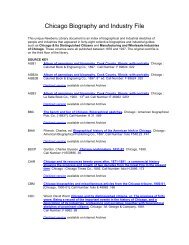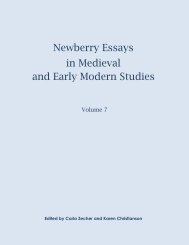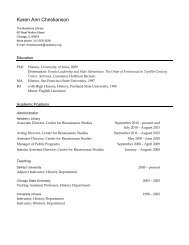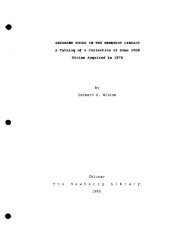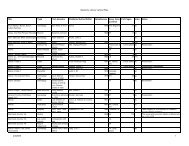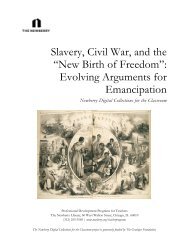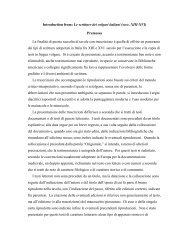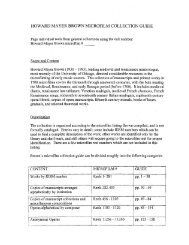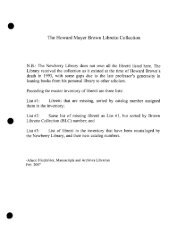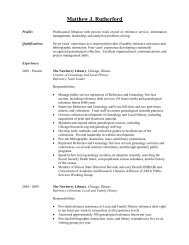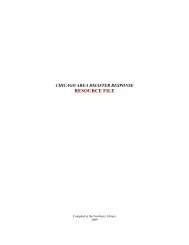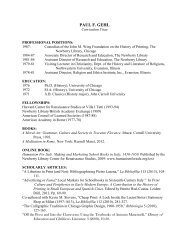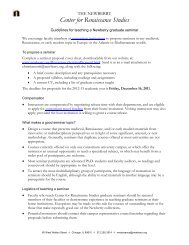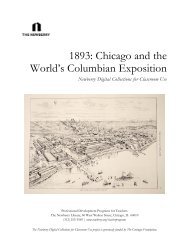You also want an ePaper? Increase the reach of your titles
YUMPU automatically turns print PDFs into web optimized ePapers that Google loves.
Historic <strong>Map</strong>s in K-12 Classrooms<br />
The Historical Geography of Transportation – <strong>Map</strong> 11<br />
The Transcontinental Rail Network, 1880<br />
<strong>Denver</strong> <strong>Pacific</strong> <strong>Railway</strong> <strong>Report</strong> <strong>and</strong> <strong>Map</strong><br />
First Annual <strong>Report</strong> of the Officers of the <strong>Denver</strong> <strong>Pacific</strong> <strong>Railway</strong> <strong>and</strong> Telegraph Company to<br />
the Stockholders. Chicago: R<strong>and</strong> McNally for the <strong>Denver</strong> <strong>Pacific</strong> <strong>Railway</strong> <strong>and</strong> Telegraph<br />
Company, 1869. pp. 20-29, with F. M. Case, “<strong>Denver</strong> <strong>Pacific</strong> <strong>Railway</strong> <strong>Map</strong> Showing the Final<br />
Location with Prospective Connections Compiled from Railroad <strong>and</strong> Govt Surveys.” Newberry<br />
Library call number: Graff 1054.<br />
CONSULTING ENGINEER’S REPORT.<br />
ENGINEER’S OFFICE, DENVER PACIFIC RAILWAY,<br />
DENVER, NOV. 19, 1868.<br />
To the President <strong>and</strong> Directors <strong>Denver</strong> <strong>Pacific</strong> <strong>Railway</strong> <strong>and</strong> Telegraph Company:<br />
SIRS- At your request I herewith submit a report showing, as far as data can be obtained, the<br />
sources from which business can be derived for your railway, <strong>and</strong> the probable chances of its<br />
being remunerative.<br />
COAL.<br />
The nearest point on the Union <strong>Pacific</strong> Railroad, where coal of a good quality can be<br />
obtained is at Carbon, 138 miles west of Cheyenne, <strong>and</strong> west of the eighty <strong>and</strong> ninety foot grades<br />
by which that railroad ascends <strong>and</strong> descends the Black Hills, <strong>and</strong> west, also, of that portion of the<br />
railroad most likely to be interrupted by snows.<br />
Between Carbon <strong>and</strong> the middle of the State of Iowa, a distance of about 1,000 miles, no<br />
coal is found on or near the line of the Union <strong>Pacific</strong> Railroad which can be used for domestic or<br />
steam purposes, <strong>and</strong> it is reasonable to suppose that for that portion of the railroad east of the<br />
Black Hills <strong>and</strong> west of Omaha, both the railroad <strong>and</strong> the country round it must be dependent on<br />
your railway for its supply of fuel, <strong>and</strong> the more so, that the country for that distance is already<br />
stripped of what timber there was on it. This dem<strong>and</strong>, at a low estimate, cannot fall short of<br />
1,000 tons per day, though, in estimating the business of your railway, I have taken but half that<br />
amount.<br />
The only questions arising in the matter, are, First, whether the coal of Colorado is of a<br />
quality to compete with all other accessible coals; <strong>and</strong>, Second, whether there is a large enough<br />
supply to meet the dem<strong>and</strong>.<br />
In regard to the quality, I cannot do better than to quote from the report of Professor F.<br />
W. Hayden, U. S. Geologist for Colorado <strong>and</strong> Wyoming. He says:<br />
“I spent two evenings at Mr. Marshall’s, burning this fuel in a furnace, <strong>and</strong> it seemed to<br />
me that it would prove to be superior to ordinary western bituminous coal, <strong>and</strong> rank next to<br />
anthracite for domestic purposes. It is as neat as anthracite, leaving no stain on the fingers. It<br />
produces no offensive gas or odor, <strong>and</strong> is thus superior in a sanitary point of view, <strong>and</strong> when<br />
brought into general use will be a great favorite for culinary purposes. It contains no destructive
elements, leaves very little ashes, no clinkers, <strong>and</strong> produces no more erosive effect on stoves,<br />
grates, or steam boilers than dry wood.”<br />
This opinion has been more than confirmed by the experience of our people for the past<br />
eight years.<br />
Mr. Lesquereux, in his report to Dr. Leconte, Geologist to the Union <strong>Pacific</strong> <strong>Railway</strong>, E.<br />
D., says, in speaking of the coal from the Boulder beds: The specimen is remarkably fine, <strong>and</strong> if<br />
the whole bed should be composed of the same material, <strong>and</strong> not intersected by clay or shale<br />
partings, its value could not be estimated too high. The coal is light, though compact, laminated<br />
in narrow, very adhesive glassy layers, without intercolation of sulphur or charcoal, marked on<br />
its vertical face by small dents, apparently scars left by the rupture of large ducts or vessels of<br />
endogenous trees (palms.) The coal contains a fair proportion of bitumen, burns with a bright<br />
yellow flame, <strong>and</strong> with a smoke which, though pretty thick, has scarcely any smell but that of<br />
wood. It does not cake at all in burning; yields about six per cent. of yellow or buff-colored<br />
ashes. This coal would serve as a most excellent fuel for locomotives.”<br />
Dr. Leconte says: “I believe, with slight modifications in the form of furnace, <strong>and</strong><br />
possibly with a small admixture of charcoal, their coals will serve for the reduction of iron ore:<br />
<strong>and</strong> that they can be used for any other smelting process required in Colorado, as well as for<br />
manufacturing purposes, is beyond a doubt.”<br />
The following is an analysis of the Boulder coal:<br />
Water at 212°.. ......................................………….......…. 8.86<br />
Volatile matter.. .........................................…………..... . 37.10<br />
Fixed Carbon ...................................…………................. 51.04<br />
Ash ..................................................………….....…….… 3.00<br />
100.00<br />
This is very excellent coal.<br />
Respectfully, WILLIAMS & MOSS,<br />
118 North Broad Street, Philadelphia.<br />
The different veins vary in gas-producing qualities, yet the coal poorest for gas, of the<br />
worked mines, will produce from 500 to 1,000 cubic feet of gas per ton-more than the best<br />
Pittsburg coals.<br />
The above, with the fact that many tons of this coal are hauled by ox teams to Cheyenne,<br />
a distance of seventy-eight miles, bringing, readily, $30 per ton at that place, while the coal from<br />
the Laramie Plains is worth only $21 per ton, is enough in regard to the quality of the Colorado<br />
coals.<br />
In regard to the quantity which is accessible to your road:<br />
Directly on the line of your road, about forty miles from <strong>Denver</strong>, toward Cheyenne, a<br />
vein has been opened of three feet in thickness, which now supplies the immediate<br />
neighborhood, <strong>and</strong>, in quality, is equal to the best.<br />
The indications are that other veins will be found near there <strong>and</strong> under your road bed. On<br />
the opposite side of the Platte, near the mouth of St. Vrain’s creek, <strong>and</strong> four miles from your<br />
line, the great Boulder vein has been opened, <strong>and</strong> its indications are found along the Platte from<br />
that point south some ten miles, <strong>and</strong> parallel with the line of your railway.
On Coal creek, twelve miles west of your line, is the mine of the <strong>Denver</strong> Gas Company.<br />
The bed is sixteen feet thick, of the best quality of coal, <strong>and</strong> highest in its gas-producing qualities<br />
of any known in Colorado. Above this, on Coal creek, extending up the creek southward eight<br />
miles, are the Chase, the Watson, the Isl<strong>and</strong>er, the Ulner, <strong>and</strong> the Baker mines, all of which have<br />
been opened on the sixteen foot vein, but the Isl<strong>and</strong>er is the only one of these now worked.<br />
All of these mines are accompanied by inexhaustible beds of iron ore (limonite) <strong>and</strong> fire<br />
clay, <strong>and</strong> by other veins of coal of from five to ten feet in thickness.<br />
These veins stretch along the base of the mountains from Ralston creek on the south to<br />
the St. Vrain on the north, a distance of about twenty miles.<br />
The Murphy mine on Ralston creek, is sixteen feet thick, but like all the veins at the<br />
immediate base of the mountains, is vertical, <strong>and</strong> of course not as available as the horizontal beds<br />
at Belmont, <strong>and</strong> on Coal creek <strong>and</strong> the Platte. The developed veins indicate a continuance of the<br />
great Boulder bed under a country about twenty miles by thirty, or six hundred square miles in<br />
extent, of which your line forms the eastern boundary, <strong>and</strong> from the whole of which it will be<br />
descending grades to your line.<br />
The present daily production of coal is as follows :<br />
<strong>Denver</strong> Gas Company’s mine ...….....……………............ 10 tons.<br />
Marshall mine ......................................………………...... 12 “<br />
Id<strong>and</strong>er mine ......................................………………........ 20 “<br />
Murphymiae ................................…………….................. 50 “<br />
Other mines ..........................................………………..... 10 “<br />
Total.. .................................…………………….……... 102 tons,<br />
per day, nearly the whole of which finds a market in <strong>Denver</strong>.<br />
The amount to which this production can be increased, is without limit; it could be<br />
readily increased to 1,000 tons per day in a week’s time, should the market dem<strong>and</strong> it.<br />
All of this coal must seek a market over your road, whether it goes to the Union <strong>Pacific</strong><br />
Railroad, or to <strong>Denver</strong>, the mountains, or to the Union <strong>Pacific</strong>, E. D.<br />
In regard to the probable dem<strong>and</strong> for cal, I append the following extract from a letter<br />
from General W. W. Fright, Chief Engineer Union <strong>Pacific</strong> <strong>Railway</strong>, E. D., to Col. Thomas<br />
A. Scott, a copy of which is furnished me by Mr. Jerry Kershaw with information that he had<br />
permission to publish it.<br />
He says: “Dr. Leconte <strong>and</strong> other eminent geologists are of the opinion that no good coal<br />
will be met with after leaving Eastern Kansas until we reach the Raton mountains on the Santa<br />
Fé line, <strong>and</strong> the <strong>Denver</strong> basin on the <strong>Denver</strong> line * * *.”<br />
The best point to get at the Raton basin is from the Red river, south of the mountains. At<br />
this point our line is estimated to be sixteen miles from the coal beds. Assuming that our railroad<br />
is to be built by Cheyenne Wells, <strong>and</strong> that the <strong>Denver</strong> Branch leaves it at or near that point, the<br />
following will be a comparison of distances to that point :<br />
RATON BASIN.<br />
From coal at Maxwell’s to Red River.. .......................….. 16 miles<br />
“ Red River to Raton Mountains.. .......................….. 64 “<br />
“ Raton to Fort Lyon.. ..................................………. 90 “<br />
“ Fort Lyon to Cheyenne Wells.. .......................…… 70 “<br />
Total.. .................................... ……… 240 miles.
DENVER BASIN.<br />
Coal mine to <strong>Denver</strong> ………………... .......................….. 16 miles<br />
<strong>Denver</strong> to Cheyenne Wells………… .......................…… 70 “<br />
Total.. ..................................... ……. 160 miles.<br />
In favor of <strong>Denver</strong>.. .....…………………………............. 80 “<br />
If it is a fact that there is no good coal no the Omaha road east of the Laramie Plains,<br />
then the <strong>Denver</strong> coal becomes a matter of great importance to that road. The Proposed road from<br />
<strong>Denver</strong> is intended to intersect that road at Pine Bluffs.<br />
The following will then be a comparison of the distances from available coal to that<br />
point:<br />
Coal in the Laramie Plains to Cheyenne.......................…165 miles<br />
Cheyenne to Pine Bluffs……………….......................…. 50 “<br />
Total………………....................................………215 miles<br />
Coal mines to <strong>Denver</strong>…………….... .......................…… 22 “<br />
<strong>Denver</strong> to Pine Bluffs……………………………………100 “<br />
Total………………....................................……...122 miles<br />
In favor of <strong>Denver</strong>.. ..................................……… 93 “<br />
(Signed)<br />
W. W. WRIGEF, Chief Engineer.<br />
Making the correction of figures, unknown to General Wright, the showing would be as follows:<br />
Boulder coals to Cheyenne……………........................… 70 miles<br />
Carbon to Cheyenne …………………….....................…138 “<br />
In favor of your road …………………........................…. 70 miles<br />
While on both the Union <strong>Pacific</strong> Railroads it range of mountains lies between the coal <strong>and</strong> the<br />
points named.<br />
LUMBER.<br />
I take it for granted that your connections will be extended up the Platte to the vast timber<br />
regions extending along the foot-hills, from Bear creek on the north to the Arkansas on the south,<br />
while the <strong>Denver</strong> Gas Company’s railway will open the timber region around the base of Long’s<br />
Peak <strong>and</strong> the Boulder basin. But even with your road completed to <strong>Denver</strong>, the amount of timber<br />
<strong>and</strong> lumber shipped from these vast forests <strong>and</strong> the pineries to the south-east of <strong>Denver</strong>, can<br />
hardly be over-estimated.<br />
During the past year nearly two millions of feet of lumber have gone from Colorado to<br />
points north <strong>and</strong> west on the Union <strong>Pacific</strong> Railroad, by wagon transportation, in some cases<br />
as far west as Green river, <strong>and</strong> the fact that the Union <strong>Pacific</strong> Railroad Company is stripping the<br />
country along its line of timber, <strong>and</strong> will require nearly a million of ties for repairs annually, <strong>and</strong><br />
vast amounts of lumber, this, with the local dem<strong>and</strong> along the line of your road, will make the<br />
forests of Colorado a source of constantly increasing revenue to your railway.
The shipments of lumber to the line of the Union <strong>Pacific</strong> Railroad during the past year,<br />
from November 1, 1867, to November 1, 1868, have been as follows:<br />
Charles’ Ruter ........................................………………. . 600,000 feet.<br />
S. A. Rice ..........................................…………………... . 210,000 “<br />
Morrison & Hallack.. ....................……………............... . 450,000 “<br />
Maxwell & Co ..............................………………............. 200,000 “<br />
Mason & Allen.. ..........................………………............ . 260,000 “<br />
Charles Hallack.. .............................………………......... .169,000 “<br />
Other dealers.. ...............................…………………...….. 100,000 “<br />
Total ……………………………………………... 1,819,000 feet.<br />
FARM PRODUCE.<br />
Until this year the farmers of Colorado have had no market for their surplus produce, <strong>and</strong>,<br />
of course, the farming interest is not what it would have been under more favorable<br />
circumstances. With a market created by your road <strong>and</strong> its connections, it is fair to estimate that<br />
the surplus will be much larger than this year, <strong>and</strong> that the whole surplus will be moved to a<br />
market over your road.<br />
Mr. W. R. Thomas, having spent the whole summer in canvassing the farms of Colorado,<br />
<strong>and</strong> obtaining the exact number of acres cultivated, <strong>and</strong> bushels of produce raised, gives me the<br />
following results, which will fall short of the actual yield, as there are many farms <strong>and</strong> valleys<br />
that he did not visit:<br />
DIVISION. WHEAT. CORN. OATS. VEGETABLES.<br />
South of <strong>Denver</strong>…<br />
North of <strong>Denver</strong>…<br />
213,136<br />
201,510<br />
414,760<br />
38,494<br />
155,180<br />
154,982<br />
619,410<br />
137,467<br />
Totals…………… 414,646 453,254 310,162 756,877<br />
In pounds………. 24,878,690 18,158,080 12,402,480 45,313,920<br />
Total, in pounds ........................................……………... . 100,753,170<br />
Estimated surplus, in pounds.. ............................………... 60,316,685<br />
It will be fair to estimate that, in a population not exceeding 50,000 north of the Sangre<br />
de Cristo mountains (<strong>and</strong> this estimate does not include the Park of the San Luis), at least onehalf<br />
of the crop will be surplus, <strong>and</strong> would go out over your road were it completed, especially as<br />
such, farm products as butter, cheese <strong>and</strong> hay are not included. This would give you the<br />
transporting of 50,376,585 pounds of produce.<br />
CATTLE.<br />
In the production of cattle, beef, wool <strong>and</strong> hides, your road will find a large transportation<br />
business.<br />
During the last year the number of cattle in Colorado has more than quadrupled, <strong>and</strong> the<br />
supply is already far in advance of any possible home dem<strong>and</strong>. With 40,000,000 acres of l<strong>and</strong>
that can only be used as pasturage, <strong>and</strong> which cattle live on the year round without other feed, no<br />
one will for an instant doubt that cattle breeding is to be the great source of wealth of Colorado.<br />
These cattle must seek a market, either as packed beef or live cattle; <strong>and</strong> will go to the<br />
great beef markets of Chicago <strong>and</strong> New York over your rod. Men of means have already<br />
commenced operations, preparatory to the packing business, on the opening of the railway. The<br />
coolness of the nights during the whole year making packing possible at all times, <strong>and</strong> the<br />
cheapness of the production of cattle, will probably cause beef to go forward in barrels.<br />
The number of cattle that have gone northward the present year is as follows:<br />
Patterson & Co.. ...............................………………......... 2,000 head.<br />
Iliff.. .............................................…………………......... 7,000 “<br />
Fowler & Co.. ...........…………………........................…. 2,000 “<br />
A. J. Williams & Co.. ................…………….................… 500 “<br />
Other dealers <strong>and</strong> forwarders. ......………........................ 2,000 “<br />
Total. ...........................…….................... . 13,500 head.<br />
ORES.<br />
Whether your railway may look to the silver <strong>and</strong> gold mining ores as a source of revenue,<br />
will depend entirely on whether it will be cheaper to bring the ores to the coal of the valley <strong>and</strong><br />
smelt them, or to ship them to Eastern smelters. Our present rates of transportation by wagon to<br />
Cheyenne, <strong>and</strong> thence by rail, <strong>and</strong> taking ore that contains $200 per ton of silver, the figures are<br />
as follows: Value of ore at Central, as paid for by smelters there, per ton, $120, no payment<br />
being made for base metals. Cost of shipping to Cheyenne, $30; from Cheyenne to Newark, $38.<br />
Total $68; as against $80 at Central.<br />
In addition to this, the Newark smelters pay for the lead <strong>and</strong> zinc contained in the ore,<br />
<strong>and</strong> as all the silver ores are also ores of lead <strong>and</strong> zinc, the loss on these metals more than<br />
compensates for the $80 per ton charged for reduction. At present prices of lead, a sixty per<br />
cent. galena is worth, for lead alone, in Newark, $144 per ton, or on ore of this character,<br />
containing $200 per ton in silver, $86 per ton in favor of shipping to Newark, even by present<br />
modes of transportation. With unlimited capacity of production in the mines, it will be fair to<br />
estimate that your road will transport large quantities of the silver ores of the country; <strong>and</strong> when,<br />
as you contemplate, you shall have extended your connections to Georgetown <strong>and</strong> Central, <strong>and</strong><br />
the vast mineral regions of the South Park, the business from this source will assume magnificent<br />
proportions. From known sources of supply, now seeking transportation, I estimate that your<br />
road will open with a business from this source of at least ten carloads per day.<br />
MISCELLANEOUS.<br />
The business of shipping wool, hides <strong>and</strong> peltry, was only commenced in July last, by but two or<br />
three firms in <strong>Denver</strong>. The shipments for the last three months have been as follows, in pounds:<br />
HIDES – By W. C. Lobenstein & co., in September.. ..........….……10,416<br />
“ October…………….……. 16,629<br />
“ November……………….. 31,251<br />
“ By James Tynon, three months.. ................……………… 2,000<br />
Total..... ........................................…………………………..…..… 60,296
WOOL – Shipped in the same time, by D.G. Peabody.......….…… 3,000<br />
“ Bartles & Co……….…… 10,000<br />
“ Hooper………………….. 30,000<br />
“ Tynon…………………… 4,000<br />
Total pounds..................................…………………………..…..… 27,000<br />
For the coming crop of wool one firm has made contracts for 200,000 pounds.<br />
PASSENGER BUSINESS.<br />
The books of the two coach lines show the present passenger business to be as follows:<br />
Wells, Fargo & Co., to <strong>Denver</strong>, per week.. .............….......116<br />
“ “ “ from <strong>Denver</strong>, per week.. .……......... 105<br />
Mason & Ganow, both ways, per week.. .......................... 96<br />
Total per week.. ............................................…………. 318<br />
An average of 46 passengers per day, <strong>and</strong> with other conveyances not less than 60 per<br />
day. With this basis, <strong>and</strong> the known increase of travel with railroad facilities, it will be a low<br />
estimate that places the travel over your road at less than 200 passengers per day.<br />
The express matter carried by the two coach lines is 2,700 pounds per month, <strong>and</strong> bullion<br />
$200,000 per month.<br />
MERCHANDISE.<br />
The incoming business of the Territory is estimated at 9,000 tons per year or 30 tons per<br />
day. This is a low estimate, <strong>and</strong> does not include my except what now passes through or to<br />
<strong>Denver</strong>, from the two Union <strong>Pacific</strong> Railroads.<br />
From the above data, I would estimate the business of your road as follows, the figures<br />
being from actual business now done, except the usual allowance on passengers <strong>and</strong> the items of<br />
coal <strong>and</strong> ore:<br />
Passengers, 200 per day.. ...............................………...… $ 441,000<br />
Produce, BUP~IUR, 60,376,586 lbs.. .....…........................ 61,882<br />
Cattle, 1600 head.. ..........................................…………… 24,000<br />
Merch<strong>and</strong>ise to <strong>Denver</strong>, 18,000,9000 lbs.. ... ..................… 176, 000<br />
Lumber, 1,519,000 feet. ......................................………… 16,911<br />
Wood, 60 car 1Qads per day ....................................…….. 225,000<br />
Ore, 10 car loads per day .....................................……….. 45,000<br />
aides <strong>and</strong> Wool, 84l,OQO lbs.. ................................…….. 4,766<br />
Express matter ................................................ …………… 20,250<br />
Total .............................................………………………. $1,003,511<br />
Deducting expenses, 50 per cent.. ...................... $501,905<br />
Net earnings ..................................……….……. 501,905
Or 14 8-10 per cent. on the capital stock of the Company, of $4,000,000.<br />
This calculation is based on the present tariff of the Union <strong>Pacific</strong> Railroad, <strong>and</strong> includes<br />
all the business of the northern portion of Colorado.<br />
The completion of &e Union <strong>Pacific</strong> <strong>Railway</strong>, E. D., to <strong>Denver</strong>, will divide this business<br />
with you, but you will be more than compensated by forming a link in one of the great through<br />
lines to the <strong>Pacific</strong>.<br />
Very Respectfully,<br />
JOHN PIERCE,<br />
Consulting Engineer <strong>Denver</strong> <strong>Pacific</strong> <strong>Railway</strong> <strong>and</strong> Telegraph Co.



